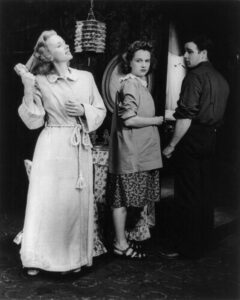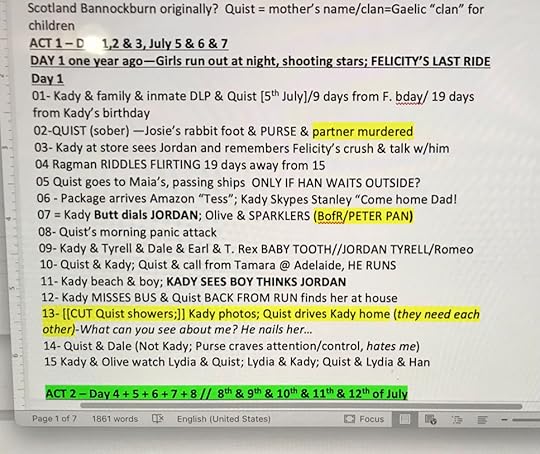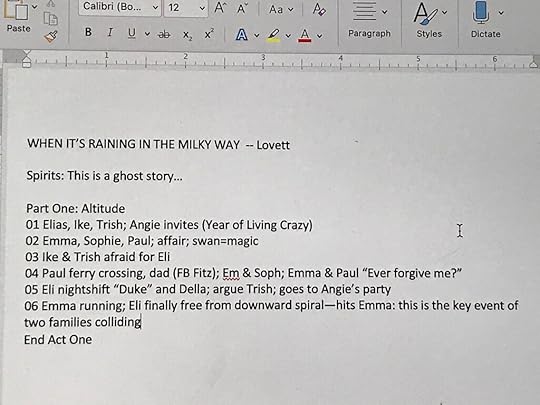Sarah Lovett's Blog
November 9, 2024
WRITING BASICS: ELEMENTS OF CRAFT IN A NUTSHELL
It’s always handy to have writing basics at your fingertips in a nutshell:
Viewpoint – The perspective you choose and use to tell your story. In the simplest terms the choices are 1st person (I), 2nd person (you, rarely used), limited 3rd person (he, she, as in a central character or protagonist), and 3rd person omniscient (sometimes defined as a godlike viewpoint, shifting between and encompassing the viewpoints of multiple characters). Viewpoint a.k.a. POV.
Summary – The efficient and active accounting of story events that otherwise are not rendered fully in a scene. Story-telling with the emphasis on the telling versus the showing. Summary is often used to transition between scenes. It also allows the writer to leap through time, covering weeks, years, even centuries, in a few lines.
Scenes – The full dramatic rendering of an episode. The reader feels as if she is witnessing the action in the present. (Half scenes are partial scenes mixed with summary.)
Action – What happens in the narrative; what happens in a scene; what a main character must be capable of.
Active voice – The subject of the sentence is the person, place, or thing in action. Spot gnawed the bone. Margo lunged across the finish line. Active voice lights up a story. Passive voice, in contrast, dulls narrative and drives editors and other readers crazy. The bone was gnawed by Spot. The book was tossed out the window by the angry reader.
Dialogue – Conversation between characters, usually with the emphasis on conflict. Dialogue is a primary tool of characterization.
Story World – When and where the story unfolds, often a reflection of the viewpoint character’s state of mind. Setting can be thought of as a container for the story’s action.
Dynamic details – Concrete and significant descriptive details that engage the reader’s senses and invite him to believe in the narrator’s and or character’s world.
Interior monologue – The thoughts of the narrator or character(s) as shared with the reader. In the case of a traditional limited 3rd person narration, the reader will only be privy to the thoughts of the viewpoint character.
Yearning – Those conscious and/or unconscious desires that propel primary characters toward the possibility of change. 
Conflict – The opposition of characters, forces, and/or worlds that is vital to narrative. Conflict may be subtle or extreme, but it must be meaningful.
Dilemma – A.K.A. Dramatic Problem a.k.a. deep story problem. The protagonist’s desire for what she wants and what she truly needs collide—–
The post WRITING BASICS: ELEMENTS OF CRAFT IN A NUTSHELL appeared first on .
January 11, 2022
Find Your Way Back to Joy in Writing
A writing life can be challenging. Sure, there are blissful days (even weeks) when you fall into your stories like you’re riding a raft with a solid paddle and no leaks, and you don’t tip over and the shining sun makes glorious rainbows in the white water’s wild spray. But there are also those days author Anne Lamott notes, “…when it all feels pointless and pitiful, like Sisyphus with cash-flow problems.” (Anne Lamott, Bird by Bird (1994)) And keep in mind, Anne Lamott is kind and funny and truthful.
 Bring joy to the writing process in 2022
Bring joy to the writing process in 2022Image by fancycrave1 from Pixabay
So how do we face these ups and downs and keep writing?
Ask for help by inviting Joy to the writing party. No, you won’t find her number on a bathroom stall. Joy is an insider. She’s a friend of Glee and a pal of Gusto and she comes from within. All she asks is that you believe in the story you’re telling—and keep the faith even when that paddle slips through your fingers and your raft springs a leak. Because it will—and you may feel like Sisyphus with bad credit—but lost paddles are part of the creative process, and your job is to find your way back to faith in your story. Find your way back to Joy.
When you seek your Joy, you’ll feel better, and facing the blank page won’t be as terrifying as checking under the bed for monsters. With Joy, you’ll smile and laugh more, and your back won’t ache, and your butt will tend to stick to the chair longer than if you’re miserable and depressed. Joy will also tell your self-doubting, self-conscious gremlins to f—k off!
And Joy brings more benefits than simply feel-good creative mojo (although very little is better than plunking down to write with a tickle in your belly). Additionally, writing with gusto and glee permeates your storytelling and fuels your distinctive writing voice with—wait for it—Joy!
James Scott Bell, a critically acclaimed author-and generous teacher-writes about the connection between voice and joy in his concise how-to, Write Your Novel From The Middle: A New Approach: “…I do think there is something to be said for trying to coax out a little more voice, even though you can never quite nail it down to pure technique. So what is it that does the coaxing? In a word, joy.”
Bell goes on to share the following quote from Clayton Meeker Hamilton: “’In the great storytellers, there is a sort of self-enjoyment in the exercise of the sense of narrative; and this, by sheer contagion, communicates enjoyment to the reader. Perhaps it may be called (by analogy with the familiar phrase, “the joy of living”) the joy of telling tales. The joy of telling tales which shines through Treasure Island is perhaps the main reason for the continued popularity of the story. The author is having such a good time in telling his tale that he gives us necessarily a good time in reading it.’ (Clayton Meeker Hamilton, A Manual of the Art of Fiction (1919)”
Bestselling, uber-prolific author, Dean Koontz, in the first book in his Odd Thomas novels, has his young, modest and gallant hero Odd share this advice from his mentor, a bestselling author named Little Ozzie. “’Give the narrative a lighter tone than you think it deserves, dear boy, lighter than you think you can bear to give it,” he instructed before I began to write, “because you won’t find the truth of life in morbidity, only in hope.’” I love this quote. And I believe it’s true.
But does this mean we should only write about the light stuff, the pretty stories, the fluff? Well, in answer to that, if you saw me now, you’d know I look a lot like the screamer in Edvard Munch’s “The Scream.” I’ll let Anne Lamott answer this: “We write to expose the unexposed. If there is one door in the castle you have been told not to go through, you must. Otherwise, you’ll just be rearranging furniture in rooms you’ve already been in. Most human beings are dedicated to keeping that one door shut. But the writer’s job is to see what’s behind it, to see the bleak unspeakable stuff, and to turn the unspeakable into words—not just into any words but if we can, into rhythm and blues.”
I’ll add one more favorite quote from my dear friend, amazing teacher, and bestselling author Alan Watt (author of The 90-Day Novel). I’ve paraphrased from a lecture during which Al mentioned this advice from his acting teacher: “Seek the joy of your own experience, even if your character is dying inside.” And whether you are writing comedy or tragedy, the stakes for your characters are always life and death!
So, this 2022, go with the gusto and find your way back to Joy! When we writers love our characters and our stories, keep the faith, and fully embrace writing with Joy—whether we are charming readers, breaking their hearts, making them laugh, and/or scaring their pants off—the Joy of “gusto mojo” communicates inexorably to readers. Toss in memorable characters, emotional truth, your personality, and style, a tight story told from your heart—and you just might end up with readers clamoring for more, more, more!
The post Find Your Way Back to Joy in Writing appeared first on .
July 15, 2021
Building Complex Characters: Actors Teaching Writers
 Jessica Tandy, Kim Hunter and Marlon Brando in the original Broadway production of A Streetcar Named Desire (1947) (Public domain image from Wikipedia)
Jessica Tandy, Kim Hunter and Marlon Brando in the original Broadway production of A Streetcar Named Desire (1947) (Public domain image from Wikipedia)I studied acting in Los Angeles in my early twenties and I went on to found and serve for five years as creative director of a nonprofit theater. One of my primary motivations was to learn about conflict, pacing and dialogue as actors embodied the words in my plays and the work of other playwrights. At the acting studio where I studied, the teacher drew techniques from the system developed by Konstantin Stanislavsky (also spelled Stanislavski) that gained prominence in America in the 1930s, known as “the method.” The method technique in a nutshell: the actor aims to bring emotional identification to the character she or he is playing with the goal of conveying psychological/emotional truth. Think of actors Dustin Hoffman and Lee Strasberg and Marlon Brando–“Stella!”
This post shares one of Stanislavsky’s techniques as detailed in his classic book Building a Character and suggests ways it can be used by writers: Personalizing.
PersonalizingPersonalizing is the process of working on character from the inside out. A person’s core truths and deepest values define how she views the world and also drive her desires and actions. Method actors grow character traits from those core values rather than simply tacking on mannerisms. Writers use personalizing, too. It’s a process of discovery. Like actors, one of our jobs is to be a student of human nature.
 Writers are people watchers
Writers are people watchersPut us in a train station, an airport, a waiting room–we watch what people do and eavesdrop on what they say and find ourselves connecting our observations to imagined core beliefs to convey emotional truths. What if…? One of the best ways to become familiar with this technique is to personalize yourself!
Make a list of some of your observable traits. For example, when you meet someone new at a party do you make eye contact or do you cast your eyes downward? Is your normal walk a stride or do you shuffle a bit? When you make a mistake do you apologize or do you go on the offensive? When you meet friends for drinks, do you grab a seat at the bar or take a table and sit with your back to the wall so you can assess the room?
Jot down several of your core beliefs. Do you believe the world rewards people who work hard? Or do you believe society rewards privilege over hard work? Do you believe most people are basically good? Or do you believe in the “Sheep, Wolf, or Sheepdog” theory? Do you believe a higher power is watching over you? Or are you agnostic? An atheist? Take your time because your list will grow.
Link one or more of your traits to one of your core beliefs. For instance, if you believe the world is divided between Sheep (innocents and followers), Wolves (predators who prey on sheep), and Sheepdogs (those who must protect the sheep from the wolves) then you might choose that corner table, keep your back to the wall and stay constantly vigilant as you assess the room. Although that’s a heavy-handed example, you get the idea.
Delve deeper. You’ve linked one of your traits to one of your core beliefs. Now delve deeper into your own character and come up with a formative experience or situation that connects to a core belief that links to a trait. If we stick with the “Sheep, Wolf, Sheepdog” example, perhaps you were raised in a military family or you were a foster child or you were raised in a cult–many situations could instill you with a hierarchical view of the world made up of prey, predator, and protector.
 King of the predators
King of the predatorsYou might have been told, Kid, it’s survival of the fittest! In contrast, you might have been imbued with a sense of duty: the strong protect the weak. Maybe you were bullied or you saw someone bullied, abused or neglected. Early experiences are formative–in life and in fiction.
Now that you’ve spent a bit of time exploring your own beliefs and traits, try studying a family member, friend, or lover. Another trick: study an interesting public personality. This is when you get to play the game, What if…?
What if your friend’s brother blinks repeatedly when he’s stressed…and what if he works in a high-pressure job where he needs to maintain the appearance of authority, strength, and control? And what if he wears very dark sunglasses, even on cloudy days? And what if he witnessed his father’s alcoholic binges when he was a kid? And what if he saw things he wishes he could forget? And what if and what if and what if!
In future posts, I’ll cover more acting techniques that writers can use to have fun creating complex, layered, fascinating characters. Remember, our traits come out of our deep beliefs. which are created by and also fortify our worldview. IOW, it’s a reinforcing loop.
More resources: To delve deep into techniques method actors can teach writers, see Brandilyn Collins’ book Getting into Character. And have fun!
We invite you to share your tips, questions, conundrums for creating complex characters–so please feel free to comment and we will respond.
The post Building Complex Characters: Actors Teaching Writers appeared first on .
March 12, 2021
A Page a Day: Tiny Habits that Get & Keep You Writing Your Stories with Ease & Joy
Embarrassing confession: I’ve been putting off writing this post on “Accountability.” Yikes. It feels good to put my failure out there–wait, let’s drop the “F” word “failure.” (We all struggle with resistance.) And let’s drop that “A” word right now, too, deal? This post is about reaching your desired outcomes (or call them goals or aspirations) with joy and ease, no failure, no shame.
Action promptsNext confession: I’ve been working on using B.J. Fogg’s Tiny Habits! This confession is awesome because his system is great and makes change so easy. It also reinforces discoveries I’ve made over the years with my own curiosity and tiny habits. For example, for more than a year, each morning when I start up the staircase to my office, I do 10 or more pushups. Admittedly, pushups on a slant are easier than if I were doing them on a level surface, but this tiny habit feels great and makes my biceps happy and firmer.
 Image by Sabine Mondestin from Pixabay
Image by Sabine Mondestin from PixabayI didn’t realize it immediately, but I was following the Tiny Habit recipe by attaching a simple new and desired behavior (10 pushups) to a daily action prompt or habit, which is taking my first step to climb the stairs to my office. 1) Easy new and desired behavior (10 pushups) attached to 2) an already established daily action prompt, climbing the staircase to my office.
Tiny = No bar too lowLet’s focus on the easy new and desired behavior. One of Fogg’s examples is his decision to floss one (count it, one!) tooth (easy new behavior) after brushing his teeth in the morning (the already established action prompt). From there he did a little research and discovered the brand of floss that worked best for his teeth. And pretty soon he was flossing all his teeth, once in the morning and once at night. I call this “no bar is too low.” In fact, setting the bar low is vital. When we set BIG goals for ourselves, they can quickly loom and overwhelm us. And then we avoid them. And then we feel like failures. No bueno! Remember, this is a practice that does not include the possibility of failure or self-blame or shame.
Lovely low bars = 3 minutes per day or 1 page per day or…?There are those writers among us who swear they sit down and whip out two-thousand words each and every day–crushing it when it comes to reaching deadlines on novels and memoirs. Bully for them! Remember, we are keeping the bar low in order to create a tiny new habit we will actually do! So your lovely low bar might be, “I want to write at least one page per day.” Alternately, it might be, “I am going to sit down at my writing desk for three minutes each day.” Great! Let’s look more closely at how to get going on your newest tiny habit. But first, one note about having fun!
 Image by Steve Buissinne from PixabayEase & Joy
Image by Steve Buissinne from PixabayEase & Joy My big words when it comes to a desired outcome while I’m writing are ease and joy! We work hard as writers so we deserve to savor and own the joy of our stories and our process, too. Even when our characters are suffering, we can seek the joy of our own writing/storytelling experience–and finish our first, second, and final polish drafts. So remember to celebrate your successes! I keep noisemakers and funny hats in my office and they remind me to smile because I love to write stories and work with writers!
Brainstorming desired outcome(s)What is the first desired writing outcome you are aiming to reach? It can be finishing draft #3 of your memoir or it can be establishing a daily writing practice or it can be a hundred other aspirations! Let’s get started by brainstorming your desired outcome. Grab a sheet of paper and outline a big cloud and now jot your aspirations anywhere you want inside that cloud. You might have “revising my short story about a boy born with wings,” or “writing a rough draft of my essay on the evolution of Disney female heroes,” or “outlining my Science Fiction epic.” Now circle the one that seems the most enticing to you or the one that’s most pressing.
 Make a contract with yourself to aim to complete your aspiration by a date on the calendar. Sign it and put it up on your wall for inspiration! Here’s one of mine. Discovering the easiest roads to reach your desired outcome(s)
Make a contract with yourself to aim to complete your aspiration by a date on the calendar. Sign it and put it up on your wall for inspiration! Here’s one of mine. Discovering the easiest roads to reach your desired outcome(s)On another piece of paper write your desired outcome in the center. Now quickly jot down behaviors that you believe will help you achieve your desired outcome. Your behaviors might include things like:
Use daily writing prompts.Do more research.Set aside an hour each day to write my pages.Make a deal with a writer friend to exchange pages.Make it even easierThese activities all make sense but they are broad and not tiny. So break them into smaller bits:
I’ll choose one writing prompt a day, take 5 minutes, and write it from my protagonist’s viewpoint.I’ll take 3 index cards and jot one research question on each card.I’ll sit at my writing desk and write for 15 minutes each day.I’ll find a coach who can support my progress and tweak my process.Now review your smaller, more specific activities and decide which ones you believe you can accomplish with ease. Set those into a “doable” pile. Aim to commit to one week of trying your new tiny habit. That will help you see if you need to break them into even smaller pieces.
And easier stillNow ask yourself, “What else can I do to make these new habits easier still?” Meaning, yes, I believe I can do them–with even more ease. Do you need help gathering writing prompts? I am very happy to support you by sending you a list to work from. You can also find many writing prompts on the web. (Mine are specifically geared to help you develop your characters and their backstories.)
 Einstein’s easy new action prompt is snoozing with his favorite toys, and when he wakes up, he’ll play for 3 minutes!
Einstein’s easy new action prompt is snoozing with his favorite toys, and when he wakes up, he’ll play for 3 minutes!Do you need to break down your research into first writing one question on a card or sticky note? Just write it down and put it where you see it. You will build up from there. What about adjusting your 30 minutes at your writing desk to, “I’m going to sit down at my writing desk for 3 minutes each day–and that’s all I need to do to start building my daily practice. ” From there, it’s very likely you will decide to write a few words and a few more words and so on. Remember, these new tiny actions you are building are habits you want to foster because they are leading you to your larger aspirations!
More action promptsFor this post, let’s revisit finding the right action prompt to inspire building your new desired habits with ease. By “right” I mean action prompts that already work for you. Let’s look at establishing a daily practice for example. One writer I know discovered that his most viable action prompt was when he pushed back his chair after finishing dinner with his family. He decided to use that action prompt to prompt him to walk straight to his writing office and sit down at his desk. He has a demanding day job and kids so this seemed his best shot. It worked! He’s writing daily, often 500 to 1,500 words per day. And he’s finishing the first draft of his first novel. Sure, he has days when he doesn’t get to his desk but it doesn’t take him long to get back on track.
Note: If he had tried that action prompt and it worked for one night but not the next, then no failure, no shame! It would simply have been the wrong action prompt for him to use. The solution=Look for new action prompts to try.
What do you need?Again, we tweak as we go. I don’t want you to feel pressured or locked into anything, but I want you to feel curious and inspired to create tiny habits that you are able to do and that move you toward your desired outcomes. Tiny steps lead to big accomplishments! Or as my dear friend Karen Kenney (writer, coach and spiritual mentor) reminds me, “Small hinges swing open big doors!”
 Tiny hinges swing open big doors!
Tiny hinges swing open big doors!Look for upcoming posts on how to reach your most treasured aspirations with ease and a smile on your face. And send us your tips and questions and recipes for success. Oh, and do check out B.J. Fogg’s excellent book Tiny Habits.
The post A Page a Day: Tiny Habits that Get & Keep You Writing Your Stories with Ease & Joy appeared first on .
February 25, 2021
Wants, Whys, Lies,& Ghosts: Use these vital story elements to reveal your characters!
Spend an hour with other writers or take a writing class and you will hear this advice: Figure out what your protagonist wants! Variations phrased as questions include: What does your hero desire? What does he yearn for? What does she lust for? What is his story goal?
Easy PeasySounds easy enough, right? Your intelligence operative wants to stop an imminent terrorist attack. Your detective wants to solve the crime. Your au pair wants to fall in love. Your corporate V.P. wants to finally earn the damn promotion! Your archaeologist wants to dig up the treasure after decades of searching!
Want something? Look outside.Notice all the “wants” listed above are focused on reaching external goals–something of the world that is tangible and measurable. Your protagonist’s “want”—or story goal—is most often something outside of themselves that can be expressed actively and represented visually. This journey toward the outer goal can be thought of as a metaphor for your hero’s inner emotional journey.
“External struggles ignite reader interest and curiosity while internal and interpersonal struggles engender empathy.” Steven James, Story Trumps Structure: How to Write Unforgettable Fiction by Breaking the Rules.
 Racing cyclists in the pelaton going for the gold!
Racing cyclists in the pelaton going for the gold!The great chase
Once she’s in gear, your hero will pursue her “want” as if it’s the only thing that matters in the world. That’s because, to her, it is. Think obsession. She pretty much believes it will solve most of her problems and the problems of her world, too. It might even make her feel whole—even though she probably doesn’t realize she needs healing, and she might deny her obsession.
On the brink!Chances are, at the beginning of your story, your protagonist is emotionally off-kilter, off-balance—or she’s on balance but soon to be knocked off her center. She is missing something and she probably doesn’t know what that something is—or maybe she doesn’t even acknowledge the empty place inside of her. We humans—and our fictional characters—are masters of denial. So now, she’s convinced that by accomplishing her outer goal, her world will be in balance again. We know that’s not true, so why doesn’t she?
“Wounds are often kept secret from others because embedded within them is the lie—the untruth that the character believes about himself…” Angela Ackerman and Becca Puglisi, Negative Trait Thesaurus
What What Why?It’s time to look at why she wants what she wants? Sure, it’s a detective’s job to find out who did the crime and track the perp down to “do the time.” But we need to look for the inner meaning your detective attaches to achieving her goal. To fit the needs of fiction, the “why” refers to the meaning the protagonist attaches to the “want.”
 Zen Garden PortlandWonder why? Look inside.
Zen Garden PortlandWonder why? Look inside.Remember the “want” (story goal) is most often external, visual, tangible, but the “why” is internal, emotional, and visceral. For example, your detective wants to solve the crime so she knows she can bring justice for the victim and balance seems restored to the world at least momentarily. Your au pair wants to fall in love to prove (to herself) that she’s lovable. Your corporate V.P. wants the promotion in order to feel validated in the eyes of her cohorts. And when your archaeologist finds the treasure, she is positive that it will be her life’s legacy. Think about it, we all attach meaning to the things we want and strive for, right? (Think about why you want to sell the books you write—now there’s a bag to unpack!) Often, we can’t verbalize the internal meaning we’ve attached to our worldly goals, but—never doubt it—those meanings exist. Here comes the hitch, at least in fiction, the protagonist’s meaning is based upon a lie she believes to be true, a.k.a., a false belief.
Hungry Ghosts and LiesSome of us are more haunted than others, but we all have “ghosts.” This is a term you might hear in a scriptwriting workshop. “Ghosts” are also called emotional “wounds.” Most of us have dated someone (or too many “someones”) with “emotional baggage.” Use whatever term gives you the most juice. Ghosts are profound experiences in life—-traumatic, acute or chronic. They often occur early in life—the loss of a parent, the witnessing of a murder, childhood neglect or abuse, or rejection by a first love. The list of possible ghosts is endless. What matters is that this wound shapes our worldview and continues to haunt us. The same must be true for your protagonist: she has a ghost that haunts her. (I like to use the term, “hungry ghost” because, in some way, it does not allow her to rest.)
 Ghostly pumpkin
Ghostly pumpkinNote: Your character may never actually understand that hungry ghost, but you, author, need to understand what it is and how it drives her to make things harder for herself. P.S. You don’t have to reveal the hungry ghost to the reader—that’s your choice.
Walking on quicksandWe humans fight to maintain the illusion of control—over our lives, our world, our experiences. If we’ve been victimized, we tell ourselves we are to blame in order to believe if we change something about our behavior, our appearance, our worldview, then we will protect ourselves from further victimization. We tell ourselves a lie—and we work very hard to hold onto our false belief. Our characters do the same thing. (Blaming ourselves is often preferable to believing we are at the whim of fate and world forces.) Someone who was rejected by her first love might tell herself, “I am not lovable. There is something wrong with me that I must fix in order to be lovable.” A rape survivor might tell himself, “My rapist recognized that I’m weak, so, to protect myself, I must never allow myself to be vulnerable again.” Someone who loses a sibling to illness might suffer from survivor’s guilt so intensely, she tells herself, “It’s my duty to save every soldier in the unit—or die trying.” You get the idea. But if the inner motivation for the hero’s “want” is based on a lie, then what? Then you—and she—need to figure out what she needs. And what she needs is the truth.
“At the heart of every story is a dilemma. If we’re not sure what our story is about, let’s consider this for a moment: Problems are solved while dilemmas are resolved through a shift in perception.” Alan Watt, The 90-day Novel
Want versus Need=the DilemmaIn the most memorable stories, the protagonist ultimately faces a dilemma between what she wants and what she truly needs in order to become more fully human, more whole. Unfortunately for the hero—but fortunately for the storyteller—even if she accomplishes her worldly goal, she will still feel empty. Your au pair may seduce the man or woman of her dreams—only to realize that she still does not feel worthy of love. Her “hungry ghost” will continue driving her to pursue external validation; it will feed her the lie that gaining love from the “right” person will make her feel lovable. But the truth is, until she discovers how to love herself, she will never be whole. Said another way: when she learns to love herself unconditionally, then she will be capable of giving and receiving unconditional love to and from others; but she will no longer desperately need it. And that is her true transformation because she has profoundly changed how she views herself and her world.
The post Wants, Whys, Lies,& Ghosts: Use these vital story elements to reveal your characters! appeared first on .
December 29, 2020
Action-Tracking Outline: Best Writing Tool Ever
Today’s post focuses on what I call the action-tracking outline, an outlining/tracking tool that might change the way you think about the “O” word. I’ve published seven novels with the big houses and I’m the author of two upcoming novels in their final stages of revision and polish–and this tool is one of the best in my writer’s toolbox.
 Image by laszlo zakarias from Pixabay
Image by laszlo zakarias from PixabayYes, I’m talking the “O” word
We’ve all heard the debate about ‘pantzers’ and ‘outliners’ and you can find many wise bloggers waxing on pros and cons of one or the other or both. That’s not what I’m writing about here. I’m sharing two partial examples of my action-tracking outlines because this tool is invaluable to me at various stages of my writing process. The key: when it comes to “O” for organizing and “O” for organic and “O” for “Oh, yep, here’s my entire narrative fitting on one or two pages!” my go-to is the action-tracking Outline.
Action is key
When putting together your action-tracking outline, hold one question at the front of your mind: What is my protagonist doing to get what she wants? The answers will be found in the decisions she makes (internal action) and the steps she takes (external action) to move toward her goal. [Note: For more on getting clear on your characters’ wants and needs, you might want to read my post: “Your Characters’ Desires Drive Your Story.”]
 Image by Free-Photos from Pixabay
Image by Free-Photos from PixabayWhen I use my action-tracking outline
Back to the “pantzers” v “outliners” question, for the record, I do not start with a set outline. I begin my stories getting to know my protagonist and what she wants and why she wants it and, ultimately, what she needs. The answers to those questions and the dilemma they create live at the thematic heart of powerful narratives.
It’s no secret in stories that grab and hold readers, all the primary characters in the story are exploring the same primal dilemma. If you’re writing a love story/RomCom for example, every major character will be exploring the dilemma of love–how to find it and, when you do, how to keep it. While your protagonist might be an innocent young man searching for true love (but unaware he doesn’t feel worthy of love–his wound), his sister might be recently divorced and expressing her jaded and bitter sentiments about love. [Note: For more on the dilemma at the heart of your story, you can see my posts: “Wants, Whys Lies & Ghosts” and “The Big Nothing, Small Deaths, and How a Dilemma is Vital for Storytellers.”]
Before I create my action-tracking outline
To get to know my protagonist, my antagonist(s), and other primary characters, I use free-writing prompts from the viewpoint of whichever character I’m writing about. Some prompts might be: I will never rest until I achieve…” and “My first memory is…” and “The secret about myself that I’ll never tell anyone is…” Using free-writes while inside the “skin” of your characters is a great way to discover your story world, characters, their backstories, and their burning desires!
I begin to discover my story markers as I learn more about my characters. That’s when the universal and primal dilemma at the heart of my story comes into more and more clarity: the dilemma of wanting love and yet not feeling worthy of love, for example; the dilemma of yearning to belong and yet discovering the cost may be giving up your moral center; the dilemma of searching for justice and yet finding yourself on the brink of committing a crime to achieve it.
Messy first draft marries action-tracking outline
I’ve usually written half or more of my messy first draft before I begin to rely on my action-tracking outline to keep me oriented. As stated earlier in the post, I don’t want to lock into a pre-set outline as I begin my messy first draft so I simply stay curious and ask questions as I work.
For example, as I write, I’m on the lookout for my inciting incident, and the end of act one, the midpoint, the end of act two, and the beginning of act three. I’m talking about holding my story very loosely, as my mentor and friend Al Watt advises repeatedly. Repeat: I do not lock my story in place during my messy (or “shitty” re. Anne Lamott) first draft. But by the time I’m moving into act two, I’m starting to yearn for my action-tracking outline. And that’s usually when I begin.
Simple and rough
The first versions of my action-tracking outlines are rough and basic! My other name for this tool is my “bare-bones outline.” Here’s a messy example from my almost fully edited novel Book of Riddles:
 a messy example of my action-tracking outline for my novel, Book of Riddles
a messy example of my action-tracking outline for my novel, Book of RiddlesEditing my action-tracking outline to serve my purposes
As you can see from the example above, I’ve included notes in my action-tracking outline and it’s really only meant to make sense to me. This is not the outline you might submit to your agent/editor/publisher as part of a book proposal. This is a working tool for you, author of your story. And the tool evolves as you work through draft one, draft two, and, often, draft three.
I’ve included an example of my cleaner action-tracking outline for my novel, When it’s Raining in the Milky Way (due out in 2021). You can see that I’ve created a lean, clean chapter by chapter version. What I’m sharing with you is the complete act one. The novel has six parts: part one is act one; parts two through five comprise act two; part six is act three.
 Final draft action-tracking outline for When it’s Raining in the Milky Way
Final draft action-tracking outline for When it’s Raining in the Milky WayYour book on two pages
For me, the biggest benefit of the lean, bare bones, action-tracking outline is that it allows me to “hold” my story in hand on two pages (three at most). When you’re writing a 300 or 400 page novel or memoir, this becomes invaluable. I am amazed how many writers come to me for guidance with their first or second draft and they might have a synopsis but they have nothing like this action-tracking outline to help them pinpoint scenes and action and turning points in their story.
I hope these examples are useful for you and please share your tips for holding your book on two (or even three) pages. We writers help each other and we’re so lucky to have a community of like-minded and supportive creatives to share our journeys, ideas, and inspirations. Until next time, wishing you ease and joy with your stories~Sarah
The post Action-Tracking Outline: Best Writing Tool Ever appeared first on .
November 3, 2020
The 3rd Person Viewpoint
I confess I never stop thinking about the interplay of the
macro and micro of story. My goal is always to provide the reader with clarity
and meaning.
Story development and structure arise out of and along with
character development.
And the story world connects inextricably to the inner life
of each story’s viewpoint character or characters.
Simply defined, the viewpoint character refers to the perspective and mind of the character through which the reader experiences the story. You might think of this character as your story’s eyes and ears and thoughts. When you use multiple characters’ viewpoints in a story, you use their perspectives one at a time, usually changing viewpoints when you begin a new scene or a new chapter. (Don’t confuse “viewpoint” with “person,” which refers to how the character will tell the story. The three options are first person (I), second person (you), and third person (s/he).
In this post I’m using three examples of a chapter opening
from final edits of one of my newest novels. The Book of Riddles is a coming
of age mystery story told in 3rd person through two primary
viewpoint characters, Detective Daniel Quist, 37, and Kady Ryder, 15.
Below are three variations on a paragraph opening a chapter
early in the novel. I was working to give a strong sense of place at the same
time allowing the reader access to a level of intimacy with Kady’s inner life.
My original paragraph has lively details from the world
around Kady. In fact it has a few too many details—hey, this was first draft.
Still, I like the sense of place.
Kady peeled out of her yard and
pedaled the nine blocks at warp speed. Clocking eight minutes from her home on
41st (racing past the Ribera’s Victorian and old Mrs. Driscoll’s
ivy-draped Spanish colonial, chased by Nippy, the weenie dog, evading the mess
of two eggs the Diepenboch twins broke over-easy on the sidewalk to fry)
cutting down tree-lined, lazy-wide M Street to the market on 48th. Driven
by the adrenaline that fueled her ever since her discovery of the Daryl Lee
Purse story. Just looking at his inmate picture left her queasy and she knew
without a doubt that she and her family would be cracked open again by this
violent stranger in the newspaper. The baking overcast sky and 98-degree-heat
rising off asphalt fired her up even more, but at least the clockwork spin of
her legs kept pace with her racing heartbeat.
This next paragraph is “lean and mean” and we experience
Kady in action and we understand she’s driven by adrenaline that comes from
something fearful and/or upsetting. (In the novel, in a previous chapter, we
see her reading a newspaper story that turns her world upside down.)
Kady
peeled out of her yard, peddling at warp speed, driven by the adrenaline that
fueled her ever since discovering the Daryl Lee Purse story. The baking
overcast sky and 98-degree heat rising off asphalt fired her up even more, but
at least the clockwork spin of her legs kept pace with her racing heartbeat.
I like the
energy of the lean paragraph—and I would use it if I didn’t want to give the
reader a much stronger sense of Kady’s world and also how the world connects to
Kady’s interior worldview, her fears, her longing, and her understanding that
she feels a loss of innocence.
This last paragraph is the one I chose for the opening of
this chapter because it gives significant details of her world, and it conveys
energy and movement, even as it connects the outer world with her inner life.
Kady
peeled out of her yard, peddling at warp speed toward Raley’s market, driven by
the adrenaline that fueled her ever since discovering the Daryl Lee Purse
story. The baking overcast sky and 98-degree heat rising off asphalt fired her
up even more, but at least the clockwork spin of her legs kept pace with her
racing heartbeat. Even as she flew past old Mrs. Driscoll’s ivy-draped
Victorian and dodged the Ribera’s weenie dog Nipper, a part of her sought
comfort in the normalcy of her neighborhood, something she and Felicity and
their families and most everyone living in these stately houses used to take
for granted.
She
couldn’t take it for granted anymore—and she was shaking her head when she made
the turn onto M Street. Was she peddling so fast in some stupid attempt to
leave bad thoughts behind? Because that just made all the bad and all the
wondering chase after her, coming much closer to biting her heels than Nipper
could ever manage.
As
her tires barely avoided the sun-fried mess of two eggs the Diepenboch twins
had broken sunny-side-up on the sidewalk, she realized she ached—and it took
her another minute to understand what that side stitch was about. She ached to
be innocent again, waking each day to a world that promised joy and adventure
without the constant shadow of life’s darkest corners, its most frightening
unknowns. As if life were an old movie and the tape could be rewound. Stop it
here, she’d shout—stop it before Felicity’s mom died and long before Felicity
went missing.
Upcoming posts will explore more of the inevitable interplay between story’s macro and micro elements—using examples from my novels and the work of other novelists. I’m someone who learns by examples. Let me know if you are, too—or if you prefer other ways of adding to your skill set. I want to help you on your journey to become your best writer, which is my own goal, too—always to learn how to be a better writer.
Happy writing, Sarah
( Photo by Vlada Karpovich from Pexels)
The post The 3rd Person Viewpoint appeared first on .
January 11, 2020
Time To Write: Use These Tips & Get Writing with Ease!
You need more time to write, right? If you’re frustrated that days pass and you don’t make it to the page of your memoir, your novel, your essay, your short story, it’s easy to start beating yourself up: I’m lazy, I don’t want it enough, I don’t have enough energy and I should be able to do it all!
So, first, put down the emotional cudgel, bat,
truncheon—stop blaming yourself which is never productive—and read on.
We talk about stories and we use words like a character’s “want” and “need.” We say characters don’t always get what they want but if the story isn’t a tragedy, they do get what they need.
When it comes to our lives, knowing the difference between what you want and what you need applies, too. You may want to learn Latin, or take up ballroom dancing, or write your supernatural thriller—and of course those are worthy desires.
 Read on and get writing with ease!
Read on and get writing with ease!Image courtesy of Geralt & Pixabay, thank you
Needs & Wants
But before you get lost in the “why can’t I find the time
when I want ‘it’ so much” first take a look at what you need and why.
If you haven’t inherited a trust fund, you probably need to
make a living so you have a roof over your head and heat and food on the table.
Those are basic needs and the costs of NOT attaining them are serious if not
dire.
Graduates of psychology 101 may remember Maslow’s Hierarchy
of Needs, a five-tier pyramid model of motivational theory based on human
needs. The first four levels of the pyramid are sometimes referred to as
“deficiency needs” while the top level—self-actualization—is about becoming all
that you can be.
The first two needs on the foundation of the pyramid are things like air, water and food, shelter, personal security, employment and resources, basic health and property. We can probably all agree that it’s easier to write when you’re not starving, freezing, or in the throes of a serious flu bug.
The next two needs on the pyramid include family and
friendship (love and connection) and recognition, respect and freedom (esteem).
Again, most of us agree we function better when we have basic connections and
enough respect and self-esteem to pursue that fifth level of human need, self-actualization.
What does all this have to do with you finding more time to write? You don’t need me to tell you that if you are using most of the time in your day to make a living and feed your family and pay the bills, you will prioritize your job(s) over less immediate needs.
Prioritize
A “priority” is one thing that is regarded as more important
than another thing. Author and coach Kristen Kieffer offers two great questions
in her new book Build Your Best Writing Life:
“Which need-based priorities serve as the
foundation of my schedule?”“Which desire-based priorities fill in the
gaps?”
If writing is your first answer to question #2—and it remains top of the list with a bit more soul-searching—then it’s time to look at what other desires (aka “wants”) you’re willing to de-prioritize in order to create more time to write. Can you hold off on the Latin lessons? Can your partner pack school lunches for your kids and supervise homework three nights a week? Can you spend a bit less time watching cute cat videos on instagram–and I know those kitties are therapeutic!
Take a good look at your schedule
Evaluate your daily/weekly schedule and assess where you have time to go beyond those things that need to get done—so you can schedule time for the writing that you so deeply want to share with the world.
 Find writing windows in unexpected places!
Find writing windows in unexpected places!image by Lisa Runnels from Pixabay, thank you
Find writing windows
See if you can discover “writing windows” that didn’t seem to exist before and offer more time to write! *If you work in an office and leave for lunch, you might choose to “bag it” and walk as far as your car, sit inside and write. *Do you walk for exercise, and, if so, what about a simple recording device so you can talk your story on the go? *Then use a transcription program to get your words onto the page. *Carry a notebook with you at all times—just by jotting notes, images, dialogue snippets, you can stay in touch with your story. *And keep a notebook next to your bed. I’ve scribbled full scenes without turning on the light.
Make a boundary with a magic marker, not kidding
For some reason it’s easier to miss a writing session than it is to miss a doctor’s appointment. Yes you need to keep appointments–and that includes the vital appointments you make with yourself to write! So when you do have enough space to block one, two, or (luxury) three hours for writing, make sure you set boundaries around that time. Let your partner know, your kids, your friends—whoever you need to tell so they will support you with your writing. And keep a physical calendar so you can magic marker an unbroken square or circle around that time. Don’t break your commitment.
Pay attention to you, stay present, stay open
When it comes to paying attention to what you need and want what you want and finding the balance that supports both—in 2020 and beyond—remember to stay present in the moment and open to your intuition and self-awareness. The goal is to move forward proactively in the direction you choose, rather than letting life lead you reactively. Be creative because you are creative!
 Stay present, stay open, invite ease
Stay present, stay open, invite easeImage by denkendewolke from pixabay, thank you
A work in process–and progress
Putting your “prioritizing” into action is a work in progress. When you look at your wants and needs and identify ways to prioritize writing, you can begin to put a new schedule into action. And! You will still need to stay on top of things. It’s a honing process, and it’s about seeing what works and what you need to tweak. You may start off scheduling time to write on four days out of the next week. If you only manage to write on two of those four days, that’s success, not failure. Tweak your new week’s schedule to include two writing days and it will be a bonus if you manage an additional day.
 Fear, anxiety and doubt can all raise their heads and show their fangs.
Fear, anxiety and doubt can all raise their heads and show their fangs.Thank you Geralt & Pixabay
The war of art–moving toward a more peaceful, easeful process
And finally, know that your own internal resistance to writing will often factor into the time/priority equation. There is a reason writer Stephen Pressfield titled his bestselling writing book The War of Art. All of us Creatives encounter internal resistance at times. Fear, anxiety and doubt all raise their heads and show their fangs. *So DO check in with yourself from time to time by using a simple free write. *Give yourself 2 or 3 minutes to respond to this question: Why am I afraid to write this book? Just scribble your answers without censoring yourself. This gives you the chance to air “hidden” internal saboteurs who might be interfering with you getting to your page.
 Image from Gert Actmann from Pixabay, thank you
Image from Gert Actmann from Pixabay, thank youPlease let us know…
We want to hear from you–how you’re doing, topics of interest, your likes and your gripes, too. This is space for writers of all stripes.
More to-come on all these topics. Please let us know how you’re doing and any future topics you want us to gab about. Here’s to writing flow and ease~Sarah
The post Time To Write: Use These Tips & Get Writing with Ease! appeared first on .
October 28, 2019
Writing Tips to Get Your Story On the Page
Writing tips can get you started! Some writers begin their writing day with a meditation. Others begin while they are still in bed and barely awake, and still others begin after walking a mile or doing pushups and crunches and drinking two cups of bitter java. Rituals are popular because they work—but not every time and not for everyone. That’s because there is often a larger undercurrent of ebb and flow to our creative process. But that doesn’t mean we should not encourage flow—we should!
Set Goals & Embrace Messy
When it comes to writing first drafts—set daily goals. Before you sit down and dive into your writing, decide where you want to be when you’re finished for the day. Don’t try to make the writing pretty or perfect; instead let it be messy—but try to reach your goal for that time allotment.
Find Just Enough Time
As a working writer, I’ve concluded that having all the time in the world to write is not a good thing. Having enough time is vital! Knowing I will have to change gears to make dinner or pick up my daughter…that helps keep me focused and I value my time.
 Find just enough time to write.
Find just enough time to write.Schedule Your Start & Stop
Decide when you’ll start and when you’ll finish each writing session, and limit your time, especially as you get back into your rhythm. Then remind yourself, you don’t have time to waste, you don’t have to get it right, you just need to get it onto the page. As you finish, make a note about what you will work on, where you will begin for your next session at the page. You might even jot down a line of dialogue or a quick exchange that you plan to use. Or keep a few handy writing tips on a sticky note at your desk.
If You Get Lost Breathe & Remember
If you feel yourself losing your way, take some deep breaths and remember what drew you to your story in the first place. What was the first seed of this narrative? It was something that stirred passion inside you and made you deeply curious. Was it a character who tapped you on your shoulder? A dilemma? A ‘what if?’ Something you witnessed? A line of dialogue over-heard? An outrage? An improbable moment of compassion? Touch that seed again and let yourself feel energy and life fill you up, and do not let your inner gremlins silence you.
Embrace Ebb & Flow
So, yes to focused meditation, and yes to keeping to a schedule and asking yourself to be disciplined and accountable. Yes to using writing tips. Yes to continuing to live your life while making it clear to those around you that you are on a heart and spirit mission to finish writing or revising your book by the end of this year or very close to it! Say yes to reminding yourself that some days getting one paragraph on the page will seem to move at a snail’s progress, while other days, writing will feel as if you’re on a surfboard catching the biggest best wave, and some days you might feel you’ve been pushed down the icy mountain on a sled! I’ll repeat myself: There is a larger undercurrent of ebb and flow to our creative process. But that doesn’t mean we should not encourage flow—we should!
 There is a larger undercurrent of ebb and flow to our creative process.
There is a larger undercurrent of ebb and flow to our creative process.The post Writing Tips to Get Your Story On the Page appeared first on .
July 19, 2019
Your Characters’ Desires Drive Your Story
Whether you are writing a novel or a memoir, the most important question you must answer is, What do my characters want? You’ll begin with your primary characters–your protagonist and major antagonist–and work from there to other characters.
Little Big “Wants”
If “what they want” seems like an easy question to answer in your stories, think again. Sure, a detective in a crime story wants to catch the bad guy and close the case. The lonely widower wants to find love. The superhero wants to save the world or at least her corner of it. Those goals (aka desires aka wants) are abstract, vague, and way too big to stand alone! It’s not that they are wrong, they are just too vast for readers to get. They are also too immense for you as a writer to work with and truly understand your characters’ motivations and share that understanding with readers.
Drill Down & Make It Small & Personal
We writers must drill down and get to the nitty gritty: of our character’s personal, specific and uniquely individual, small (sometimes even mundane, sometimes teeny-tiny) desires. What if that detective, on the brink of retirement after an almost-unblemished career, wants to be able to collect his pension and sit in his barcalounger, feet up, recording the fall migration of the broad-winged hawk? But he’s always been a bit OCD (it served him well in his career) but now at the end, he cannot rest (put those feet up–and oh boy does he have painful bunions) until he finds the one missing piece of evidence that will prove the bad guy did it. And what if that bad guy is the surviving husband of the detective’s murdered niece? Now most readers are along for the ride because they understand the detective’s goal–it’s specific, it’s very personal (he’s got skin in the game), and it is small in the sense of measurable. We know what is at stake! If he succeeds, his sister’s murder will be avenged, he will finally rest easy, and justice will be served in an often-unjust world. Making goals personal is vital to grounding an arch good vs evil plot–and just as important when it comes to tightening and narrowing a character’s choices in a coming of age story or a psychological family drama.
Bundles of Wants
We humans are nothing if not a bundle of wants–whether we want to eat ice cream, get the job, save the world, we want! As readers, we may feel lukewarm about a character who only wants to save the world, crazy as that might seem. But we begin with an innate understanding of a character who wants to save her child from danger–a cyberbully, a career blunder, a breakdown.
Making Meaning
We set goals–to win our beloved’s love, to find the perfect publisher for our book, to fly to Australia and join a spiritual walkabout–and then it’s our nature to make meaning out of accomplishing our goals. When my love loves me, I will be complete. When my book is published I will prove my worth to my father, my family and the world. When I return from my walkabout in Australia I will finally know who I am! Of course it’s never that simple–not for us in our lives and not for our characters. Our protagonist’s lover returns her love but she still feels incomplete. Our hero’s book sells like hotcakes but his father still loves his older brother more! Our protagonist has to be rescued during her walkabout and she returns from Australia feeling even more lost than before.
The Lie We Want to Believe
In narrative your character never gets what she wants–not really. If she takes every action possible to make her beloved fall head over heels, she ends up jilted at the altar. Or, if she does win her beloved’s deepest affection–believing that love will complete her–she wakes up in bed with her lover beside her, and still she feels that empty space inside. She never gets what she wants because she’s invested in a false belief. If my lover loves me, I will be complete. If my lover doesn’t love me, I will despair and die. (Remember, in every story–even comedy–the stakes for the major characters are life and death.)
Just Might Get What You Need
In pursuing their goals, no holds barred, our characters race toward the result they desperately desire. They dash toward the result and the meaning they attach to that desire. When they hit the wall the story doesn’t end. Story is all about conflict–the fight to get what she/he wants. That fight is what energizes our characters, what makes them worthy of following–that fight is why we read the books we love. When stories are strong and well-told, we as readers experience the characters’ struggles and we glean their motivations by understanding the meaning they ascribe to achieving their goals. Put another way we understand the primal dilemma at the heart of their desire. (For more, read: How a Dilemma is Vital for Storytellers.) We root for them and against them, all the while glad that we don’t have to stand in their shoes. We experience them speeding toward the finish line but hitting a wall instead. That wall represents loss and the dark night of the soul and the last gasps of fight to failure. Again, the story doesn’t end at that wall. Instead the story turns from fight to surrender. To giving up. To realizing that what they wanted and believed they would gain by fighting is not to be. And this is turning point to the 3rd act.
Whatever Doesn’t Kill You…
In narrative, the death of a dream, the death of a passionately held desire, is the doorway to a new way of seeing the world. In mythic story terms the hero dies to an old way of believing only to awaken to a new way of seeing her world. She must prove to the gods that her transformation is real–and her proof is the action she takes. Only then can she receive the gift of new wisdom–she returns with the elixir. Think back to our protagonist who fought for love only to be left at the altar, which was the death of her dream that another’s love would make her worthy of love, make her whole. After the despair, the ‘death’, she awakens to the fact she is still alive and breathing. As the days pass she hauls herself out of bed, and just maybe she begins to recognize the pain in others who are lonely. As she focuses on helping others she experiences a healing of her own. She understands that she doesn’t need someone else to make her whole, to complete her, to make her worthy of love. She is already whole and she gives love to herself while she reaches out to others. That’s one way her story might end. And, hey, while she is doing good work, she just might find love in her life from a special someone. And if she does, that is icing on the cake. It’s not that she ever loses the longing for love–we humans want and want and want–but she understands her life and its meaning in a new way. Her desires have driven her from the story’s opening to its end. The same is true for a character driven to a dark and/or tragic end–although in that case, it is the reader who experiences the awakening and gains new insight.
Try This:
Relax with a pencil and pad and put your feet up and ask yourself, What do my characters want? Now make a list of everything your protagonist wants/yearns for/desires in her life–big goals, medium goals, and small goals. Write fast and don’t censor anything. Aim for specific, personal, skin-in-the-game goals. Now see which of her wants align with the story you are telling. Now make a new list for everything your primary antagonist desires–and break those desires down into the nitty gritty. And so on with all your major characters. (You may begin to notice that, at heart, all your characters share the same driving primal desire. This shared “want” is your way to thematic unity in your story. But more about that in another post.) The answers to this question–what does she/he want?–will drive your characters and they in turn will drive the story from inciting incident to midpoint to final climax!
The post Your Characters’ Desires Drive Your Story appeared first on .



